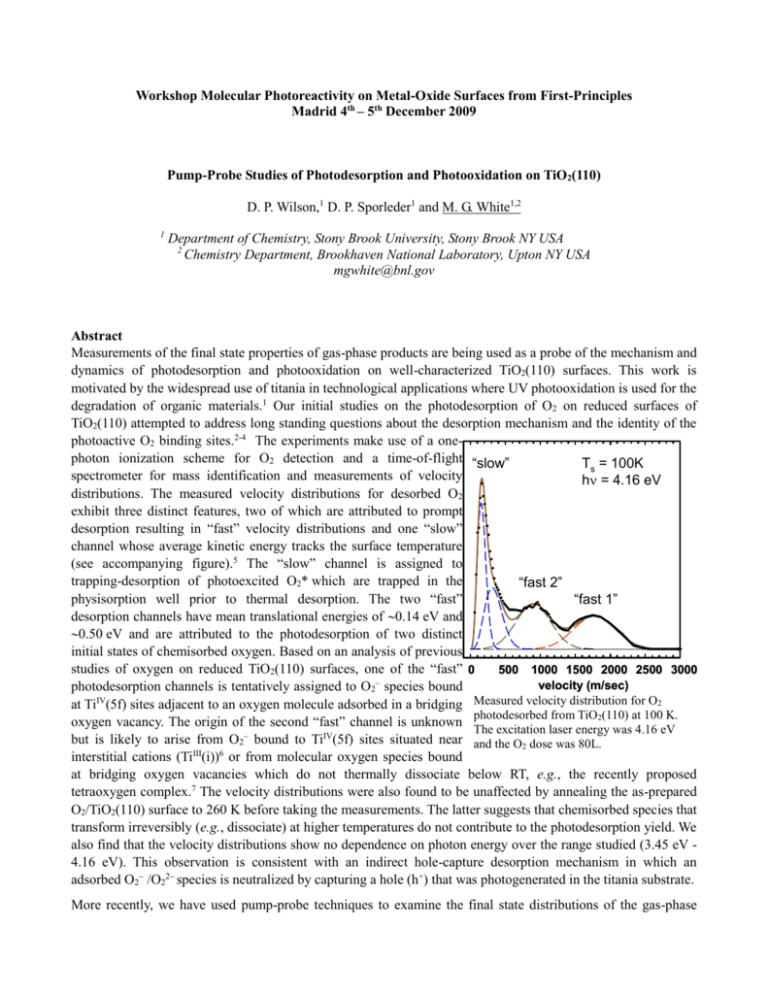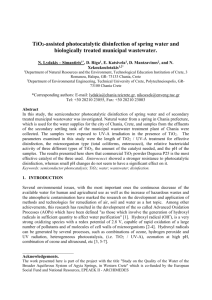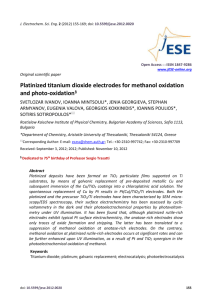Workshop Molecular Photoreactivity on Metal
advertisement

Workshop Molecular Photoreactivity on Metal-Oxide Surfaces from First-Principles Madrid 4th – 5th December 2009 Pump-Probe Studies of Photodesorption and Photooxidation on TiO2(110) D. P. Wilson,1 D. P. Sporleder1 and M. G. White1,2 1 Department of Chemistry, Stony Brook University, Stony Brook NY USA 2 Chemistry Department, Brookhaven National Laboratory, Upton NY USA mgwhite@bnl.gov Abstract Measurements of the final state properties of gas-phase products are being used as a probe of the mechanism and dynamics of photodesorption and photooxidation on well-characterized TiO2(110) surfaces. This work is motivated by the widespread use of titania in technological applications where UV photooxidation is used for the degradation of organic materials.1 Our initial studies on the photodesorption of O2 on reduced surfaces of TiO2(110) attempted to address long standing questions about the desorption mechanism and the identity of the photoactive O2 binding sites.2-4 The experiments make use of a onephoton ionization scheme for O2 detection and a time-of-flight “slow” Ts = 100K spectrometer for mass identification and measurements of velocity h = 4.16 eV distributions. The measured velocity distributions for desorbed O2 exhibit three distinct features, two of which are attributed to prompt desorption resulting in “fast” velocity distributions and one “slow” channel whose average kinetic energy tracks the surface temperature (see accompanying figure).5 The “slow” channel is assigned to trapping-desorption of photoexcited O2* which are trapped in the “fast 2” physisorption well prior to thermal desorption. The two “fast” “fast 1” desorption channels have mean translational energies of 0.14 eV and 0.50 eV and are attributed to the photodesorption of two distinct initial states of chemisorbed oxygen. Based on an analysis of previous studies of oxygen on reduced TiO2(110) surfaces, one of the “fast” 0 500 1000 1500 2000 2500 3000 velocity (m/sec) photodesorption channels is tentatively assigned to O2– species bound IV Measured velocity distribution for O2 at Ti (5f) sites adjacent to an oxygen molecule adsorbed in a bridging photodesorbed from TiO2(110) at 100 K. oxygen vacancy. The origin of the second “fast” channel is unknown The excitation laser energy was 4.16 eV but is likely to arise from O2– bound to TiIV(5f) sites situated near and the O2 dose was 80L. interstitial cations (TiIII(i))6 or from molecular oxygen species bound at bridging oxygen vacancies which do not thermally dissociate below RT, e.g., the recently proposed tetraoxygen complex.7 The velocity distributions were also found to be unaffected by annealing the as-prepared O2/TiO2(110) surface to 260 K before taking the measurements. The latter suggests that chemisorbed species that transform irreversibly (e.g., dissociate) at higher temperatures do not contribute to the photodesorption yield. We also find that the velocity distributions show no dependence on photon energy over the range studied (3.45 eV 4.16 eV). This observation is consistent with an indirect hole-capture desorption mechanism in which an adsorbed O2 /O22 species is neutralized by capturing a hole (h+) that was photogenerated in the titania substrate. More recently, we have used pump-probe techniques to examine the final state distributions of the gas-phase products resulting from the photooxidation of small organic molecules on TiO2(110). Recent experiments by Henderson using a UV lamp source showed that the photooxidation of small ketones on the TiO 2(110) surface results in the direct ejection of radical species into the gas phase. 8, 9 Initial studies of acetone (CH3COCH3) and butanone (CH3CH2COCH3) co-adsorbed with O2 on TiO2(110) show that the primary gas-phase products of photooxidation (h = 3.70 eV) are methyl radical (CH3) and ethyl radical (C2H5) with average translational energies of 0.15 eV and 0.05 eV, respectively. In the case of butanone, we used a variety of VUV ionization wavelengths to show that other C2 hydrocarbon products (ethane or ethylene) proposed in previous studies are not formed to any significant extent. The methyl radical translational energy distribution is markedly different than that observed in gas-phase photolysis of acetone, and can be empirically fit to a “fast” and a “slow” component. The “fast” component is attributed to a prompt intramolecular fragmentation process of the molecular precursor (surface diolate species) and the “slow” component may be associated with methyl internal energy or a second fragmentation channel. References 1. A. Fujishima, T. N. Rao, and D. A. Tryk, J. Photochem. and Photobiol. C: Photochem. Rev. 1, 1 (2000). 2. T. L. Thompson and J. T. Yates, Jr., Topics Catal. 35, 197 (2005). 3. M. A. Henderson, W. S. Epling, C. L. Perkins, C. H. F. Peden, and U. Diebold, J. Phys. Chem. B 103, 5328 (1999). 4. M. P. de Lara-Castells, A. O. Mitrushenkov, O. Roncero, and J. L. Krause, Israel J. Chem. 45, 59 (2005). 5. D. Sporleder, D. P. Wilson, and M. G. White, J. Phys. Chem. C 113, 13180 (2009). 6. S. Wendt, P. Sprunger, T., E. Lira, G. K. H. Madsen, Z. Li, J. O. Hansen, J. Matthiesen, A. Blekinge-Rasmussen, E. Laegsgaard, B. Hammer, and F. Besenbacher, Science 320, 1755 (2008). 7. D. Pillay, Y. Wang, and G. S. Hwang, J. Amer. Chem. Soc. 128, 14000 (2006). 8. M. A. Henderson, J. Phys. Chem. B 109, 12062 (2005). 9. M. A. Henderson, Surf. Sci. 602, 3188 (2008).







